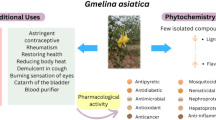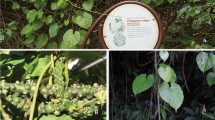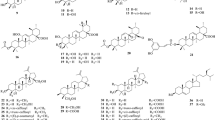Abstract
In this review article, the ethnobotanical, phytochemical, and pharmacological properties of Cerbera manghas L. (Apocynaceae) are discussed. This plant has applications in traditional folk medicine as analgesic, anticonvulsant, a cardiotonic and for hypotensive activity. Phytoconstituents of this plant are secondary metabolites like saponins, terpenoids, and alkaloids along with phenolic acids, flavonoids, cardiac glycosides, steroids, iridoids, lignans, and other compounds. The major phytochemical compounds are cardiac glycosides followed by terpenoids and phenolic acids. Again, the leaf has greater types and numbers of phytochemicals, followed by the fruit, seed, stem, and root. The plant also shows many pharmacological activities such as antioxidant, anticancer, anti-inflammatory, DNA damage protection, and antimicrobial. This review could help researchers in further investigations in these directions.

Similar content being viewed by others
References
Ali AM, Mackeen MMM, EI-Sharkawy, et al. 1996 Antiviral and cytotoxic activities of some plants used in Malaysian indigenous medicine Pertanika. J. Trop. Agric. Sci. 19 129–136
Anwar HM, Amirul IM, Suman S, Mushfiqur R and Afjalus SM 2013 Assessment of phytochemical and pharmacological properties of ethanolic extract of Cerbera manghas L. leaves. Int. Res. J. Pharm. 4 120–123
Barceloux DG 2012 Medical Toxicology of Natural Substances: Foods, Fungi, Medicinal Herbs, Plants, and Venomous Animals (Wiley) p 857
Basak UC, Das AB and Das P 1995 Metabolic changes during rooting in some cutting of 5 mangroves species of Orissa. Plant. Growth. Regul. 17 141–148
Basak UC, Das AB and Das P 2000 Rooting response in stem cuttings from five species of mangrove trees: effect of Auxins and enzyme activities. Mar. Biol. 136 185–189
Cao LL, Tian HY, Wang YS, Zhou X, Jiang R and Liu YH 2013 Chemical constituents in fruits of mangrove plant Cerbera manghas L. J. Chin. Pharm. Sci. 48 1052–1056
Chan EWC, Wong SK, Chan HT, Baba S and Kezuka M 2016 Cerbera are coastal trees with promising anticancer properties but lethal toxicity: a short review. J. Chin. Pharm. Sci. 25 161–169
Chang LC, Gills JJ, Bhat KP, Luyengi L, Farnsworth NR, Pezzuto JM and Kinghorn AD 2000 Activity-guided isolation of constituents of Cerbera manghas with antiproliferative and antiestrogenic activities. Bioorg. Med. Chem. Lett. 10 2431–2434
Cheenpracha S, Karalai C, Rat-A-Pa Y, Ponglimanont C and Chantrapromma K 2004 New cytotoxic cardenolide glycoside from the seeds of Cerbera manghas. Chem. Pharm. Bull. 52 1023–1025
Eddleston M and Persson H 2003 Acute plant poisoning and antitoxin antibodies. J. Toxicol. Clin. Toxicol. 41 309–315
Eganathan P, Rao CS and Anand A 2000 Vegetative propagation of three mangrove tree species by cutting and air-layering. Wetl. Ecol. Manag. 8 281–286
Feng B, Guo YW, Huang CG, Li L and Jiao BH 2012 β-d-Glucosyl-(1–4)-α-l-thevetosides of 17β-digitoxigenin from seeds of Cerbera manghas L. induces apoptosis in human hepatocellular carcinoma HepG2 cells. Exp. Toxicol. Pathol. 64 403–410
Feng B, Guo YW, Huang CG, Li L, Chen RH and Jiao BH 2010 2′-epi-2′-O-Acetylthevetin B extracted from seeds of Cerbera manghas L. induces cell cycle arrest and apoptosis in human hepatocellular carcinoma HepG2 cells. Chem.-Biol. Interac. 183 142–153
Fern K 2014 Useful tropical plants database. Cerbera manghas. http://tropical.theferns.info/query.php?full=Cerbera+manghas
GBIF (Global Biodiversity information Facility) Backbone Taxonomy. Cerbera manghas L. in GBIF Secretariat 2019. Checklist dataset. https://doi.org/10.15468/39omei accessed via GBIF.org
Govaerts R 2003 World Checklist of Selected Plant Families Database in ACCESS: 1-216203. The Board of Trustees of the Royal Botanic Gardens, Kew. www.plantsoftheworldonline.org/taxon/urn:lsid:ipni.org:names:60436653-2
Hossain MAASM, Sarkar S, Saha S and HossainHasan MLMM 2013 Biological assessment on Cerbera manghas (linn.). Pharmacol. Online Arch. 1 155–160
Iawsipo P, Choksawangkarn W, Promdan C and Nilkasam P 2017 Antibacterial and antioxidant activities of Cerbera manghas and C. odollam leaf extracts. Burapha Sci. J. 22 1–12
Iqbal Z, Iqbal MS and Mishra K 2017 Screening of antioxidant property in medicinal plants belonging to the family Apocynaceae. Asian J. Pharm. Clin. Res. 10 415–418
Jeong HY, Sung GH, Kim JH, Yoon JY, et al. 2014 Syk and Src are major pharmacological targets of a Cerbera manghas methanol extract with kaempferol-based anti-inflammatory activity. J. Ethnopharmacol. 151 960–969
Kour A 2014 Plants exhibiting potential for cancer treatment. Int. J. Pharm. Sci. Rev. Res. 27 23–53
Lee SK, Mbwambo ZH, Chung H, Luyengi L, Gamez EJ, Mehta RG, Kinghorn AD and Pezzuto JM 1998 Evaluation of the antioxidant potential of natural products. Comb. Chem. High Throughput Screen. 1 35–46
Leeuwenberg AJM 1999 Flora of Tropical East Africa. Wageningen Agric. Univ. Pap. 98(3) 5–64. http://www.plantsoftheworldonline.org/taxon/urn:lsid:ipni.org:names:60436653-2
Lemmens RHMJ 2006 Cerbera manghas L. in PROTA (Plant Resources of Tropical Africa/Ressources végétales de l’Afrique tropicale) (eds) Schmelzer GH and Gurib-Fakim A (Wageningen, Netherlands)
Liu PC, Liu MH, Chen SY, Cherng WJ and Wang CH 2008 Sea mango cardiac intoxication. Acta Cardiol. Sin. 24 9–56
Maharana PK and Basak UC 2015 Salt induced morpho-biochemical changes in vegetatively propagated back mangrove Cerbera manghas during hardening. J. Appl. Environ. Biol. Sci. 5 127–133
Maharana PK and Basak UC 2020 Effect of NaCl on bio-molecular changes during hardening of vegetatively propagated mangrove species Cerbera manghas. Int. J. Bot. Stud. 5 41–45
Musdja MY, Aeni M and Djajanegara I 2018 Comparison of antibacterial activities leaves extracts of Cerbera manghas and leaves extracts of Azadirachta indica against Klebsiella pneumoniae. Asian J. Pharm. Clin. Res. 11 51–55
Musdja MY and Chadidjah Djajanegara I 2019 Antibacterial activity of dichloromethane and ethyl acetate extracts of bintaro leaf (Cerbera manghas L.) against Staphylococcus aureus and Escherichia coli. Int. J. Curr. Res. 11 398–402
Rajathi FAA and Nambaru VRMS 2014 Phytofabrication of nano-crystalline platinum particles by leaves of Cerbera manghas and its antibacterial efficacy. Int. J. Pharma. Bio. Sci. 5 619–628
Sakushima A, Nishibe S, Hisada S, Noro Y and Hisada Y 1976 Studies on the constituents of Apocynaceae plants; isolation of flavonol glycosides and some other components from the leaves of Cerbera manghasL. Yakugaku Zasshi 96 1046–1048
Scott S and Thomas C 2000 Poisonous Plants of Paradise: First Aid and Medical Treatment of Injuries from Hawaii’s Plants (Honolulu, HI: University of Hawaii Press) p 37
Sukmawati D 2016 Antagonism mechanism of fungal contamination animal feed using phylloplane yeasts isolated from the bintaro plant (Cerbera manghas) Bekasi in Java, Indonesia. Int. J. Curr. Microbiol. App. Sci. 5 63–74
Susilo A, Haryanta D and Sa’adah TT 2019 Response of Riptortus linearis towards the aplication of Bintaro (Cerbera manghas) leaf extract, Eurasia. J. Biosci. 13 2217–2224
Tarmadi D, Himmi SK and Yusuf S 2014 The efficacy of the oleic acid isolated from Cerbera manghas L. seed against a subterranean termite, Coptotermes gestroi Wasmann and a drywood termite, Cryptotermes cynocephalus Light. Proc. Environ. Sci. 20 772–777
Upadhyay VP, Mishra PK and Sahu JR 2008 Distribution of Mangrove Species within Bhitarkanika National Park in Orissa, India. Trees Life J. 3 4
Ved DK, Kinhal GA, Ravikumar K, Sankar RV, Sumathi R, Mahapatra AK et al. 2008 Conservation Assessment & Management Prioritisation for Medicinal Plants of Orissa. A synthesis of Regional expertise in medicinal plants Taxonomy & Distribution through a workshop held at Bhubaneswar during 7th-10th October 2007. Regional Plant Resource Centre, Bhubaneswar & FRLHT, Bangalore 2008, pp 45
Ved DK, Sureshchandra ST, Barve V, Srinivas V, Sangeetha S, Ravikumar et al. 2016 Cerbera manghas L., india biodiversity portal. FRLHT's ENVIS Centre on Medicinal Plants, Bengaluru. FRLHT, Bengaluru and MoEFCC, GoI
Wiart C 2006 Medicinal Plants of Asia and Pacific (Boca Raton: CRC Press/Taylor and Francis)
Wanga G, Guo Y, Fenga B, Li L, Huanga C and Jiaoa B 2010 Tanghinigenin from seeds of Cerbera manghas L. induces apoptosis in human promyelocytic leukemia HL-60 cells. Environ. Toxicol. Pharmacol. 30 31–36
**aopo Z, Yue-hu P, Ming-sheng L, Sheng-li K and Jun-qing Z 2010 Chemical constituents from the leaves of Cerbera manghas. Asian Pac. J. Trop. Med. 3 109–111
Yamauchi T, Abe F and Wan ASC 1987 Studies on Cerbera. IV.1 Polar cardenolide glycosides from the leaves of Cerbera odollam and Cerbera manghas. Chem. Pharm. Bull. 35 4813–4818
Yan LH 2010 Study on the chemical constituents of Cerbera manghas. Thesis. Hainan University
Yi YS, Cho JY and Kim D 2016 Cerbera manghas methanol extract exerts anti-inflammatory activity by targeting c-Jun N-terminal kinase in the AP-1 pathway. J. Ethnopharmacol. 193 387–396
Yu S and Qin H 2019 Botanic Gardens Conservation International (BGCI) & IUCN SSC Global Tree Specialist Group. Cerbera manghas. The IUCN Red List of Threatened Species 2019
Zhang XP, Liu MS, Zhang JQ, Kang SL and Pei YH 2009 Chemical constituents from the bark of Cerbera manghas. J. Asian Nat. Prod. Res. 11 75–78
Zhang X, Pei Y, Liu M, Kang S and Zhang J 2010 Chemical constituents from the leaves of Cerbera manghas. Asian Pac. J. Trop. Med. 3 109–111
Zhang XP, Pei YH, Liu MS, Kang SL and Zhang JQ 2011 Triterpenoids from the leaves of Cerbera manghas. Nat. Prod. Res. Dev. 23 443
Zhao Q, Guo Y, Feng B, Li L, Huang C and Jiao B 2011 Neriifolin from seeds of Cerbera manghas L. induces cell cycle arrest and apoptosis in human hepatocellular carcinoma HepG2 cells. Fitoterapia 82 735–741
Author information
Authors and Affiliations
Corresponding author
Additional information
Corresponding editor: BJ Rao
Rights and permissions
About this article
Cite this article
Maharana, P.K. Ethnobotanical, phytochemical, and pharmacological properties of Cerbera manghas L.. J Biosci 46, 25 (2021). https://doi.org/10.1007/s12038-021-00146-6
Received:
Accepted:
Published:
DOI: https://doi.org/10.1007/s12038-021-00146-6




